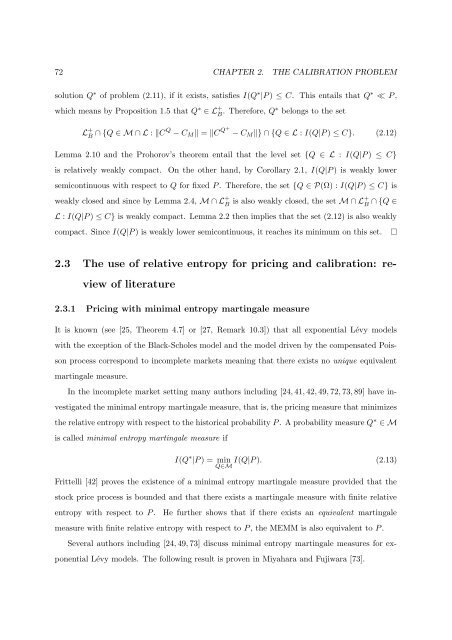Processus de Lévy en Finance - Laboratoire de Probabilités et ...
Processus de Lévy en Finance - Laboratoire de Probabilités et ...
Processus de Lévy en Finance - Laboratoire de Probabilités et ...
Create successful ePaper yourself
Turn your PDF publications into a flip-book with our unique Google optimized e-Paper software.
72 CHAPTER 2. THE CALIBRATION PROBLEM<br />
solution Q ∗ of problem (2.11), if it exists, satisfies I(Q ∗ |P ) ≤ C. This <strong>en</strong>tails that Q ∗ ≪ P ,<br />
which means by Proposition 1.5 that Q ∗ ∈ L + B . Therefore, Q∗ belongs to the s<strong>et</strong><br />
L + B ∩ {Q ∈ M ∩ L : ‖CQ − C M ‖ = ‖C Q+ − C M ‖} ∩ {Q ∈ L : I(Q|P ) ≤ C}. (2.12)<br />
Lemma 2.10 and the Prohorov’s theorem <strong>en</strong>tail that the level s<strong>et</strong> {Q ∈ L : I(Q|P ) ≤ C}<br />
is relatively weakly compact. On the other hand, by Corollary 2.1, I(Q|P ) is weakly lower<br />
semicontinuous with respect to Q for fixed P . Therefore, the s<strong>et</strong> {Q ∈ P(Ω) : I(Q|P ) ≤ C} is<br />
weakly closed and since by Lemma 2.4, M ∩ L + B is also weakly closed, the s<strong>et</strong> M ∩ L+ B ∩ {Q ∈<br />
L : I(Q|P ) ≤ C} is weakly compact. Lemma 2.2 th<strong>en</strong> implies that the s<strong>et</strong> (2.12) is also weakly<br />
compact. Since I(Q|P ) is weakly lower semicontinuous, it reaches its minimum on this s<strong>et</strong>.<br />
2.3 The use of relative <strong>en</strong>tropy for pricing and calibration: review<br />
of literature<br />
2.3.1 Pricing with minimal <strong>en</strong>tropy martingale measure<br />
It is known (see [25, Theorem 4.7] or [27, Remark 10.3]) that all expon<strong>en</strong>tial Lévy mo<strong>de</strong>ls<br />
with the exception of the Black-Scholes mo<strong>de</strong>l and the mo<strong>de</strong>l driv<strong>en</strong> by the comp<strong>en</strong>sated Poisson<br />
process correspond to incompl<strong>et</strong>e mark<strong>et</strong>s meaning that there exists no unique equival<strong>en</strong>t<br />
martingale measure.<br />
In the incompl<strong>et</strong>e mark<strong>et</strong> s<strong>et</strong>ting many authors including [24, 41, 42, 49, 72, 73, 89] have investigated<br />
the minimal <strong>en</strong>tropy martingale measure, that is, the pricing measure that minimizes<br />
the relative <strong>en</strong>tropy with respect to the historical probability P . A probability measure Q ∗ ∈ M<br />
is called minimal <strong>en</strong>tropy martingale measure if<br />
I(Q ∗ |P ) = min I(Q|P ). (2.13)<br />
Q∈M<br />
Frittelli [42] proves the exist<strong>en</strong>ce of a minimal <strong>en</strong>tropy martingale measure provi<strong>de</strong>d that the<br />
stock price process is boun<strong>de</strong>d and that there exists a martingale measure with finite relative<br />
<strong>en</strong>tropy with respect to P .<br />
He further shows that if there exists an equival<strong>en</strong>t martingale<br />
measure with finite relative <strong>en</strong>tropy with respect to P , the MEMM is also equival<strong>en</strong>t to P .<br />
Several authors including [24, 49, 73] discuss minimal <strong>en</strong>tropy martingale measures for expon<strong>en</strong>tial<br />
Lévy mo<strong>de</strong>ls. The following result is prov<strong>en</strong> in Miyahara and Fujiwara [73].
















